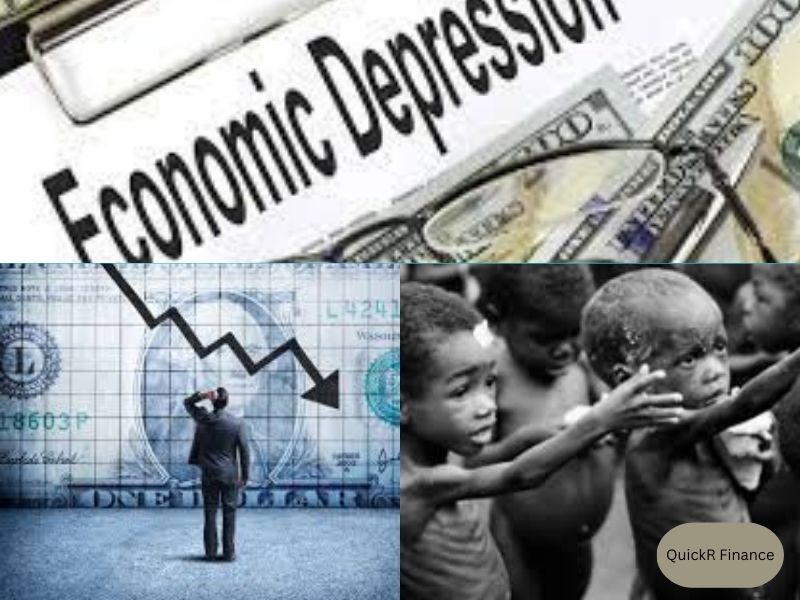Economic depressions are defined as prolonged periods of economic decline, characterized by high unemployment rates, a decrease in economic output, and a general decline in the overall economic well-being of a region or country. These events are often preceded by a period of economic growth and financial excess, which then leads to a sudden and severe contraction of the economy. Throughout history, there have been several notable examples of economic depressions, each with their own unique characteristics and causes.
One of the earliest recorded examples of an economic depression occurred during the 3rd century in the Roman Empire. The decline in the economy was attributed to a series of military defeats and financial crises that occurred during this period, which ultimately led to high levels of unemployment, widespread poverty, and a significant contraction of the economy.
Another significant example of an economic depression occurred during the Long Depression of the late 19th century, which began with the Panic of 1873. The panic was caused by the collapse of the investment bank Jay Cooke & Company, which triggered a wave of bank failures and bankruptcies. The depression lasted for nearly 25 years, and during this period, unemployment rates reached 14% in the United States and Europe.
One of the most well-known and severe economic depressions in history was the Great Depression of the 1930s. The Great Depression was caused by several factors, including the stock market crash of 1929, a decrease in consumer spending, and a general lack of confidence in the banking system. Unemployment rates during this period reached 25% in the United States, and the depression ultimately led to significant social and political upheaval.
More recently, the global financial crisis of 2008 can also be considered an economic depression. The crisis was caused by a variety of factors, including the collapse of the housing market and a wave of mortgage defaults. The crisis ultimately led to widespread unemployment, bankruptcies, and a significant contraction of the global economy.
Throughout history, the causes of economic depressions have varied widely, ranging from military conflict to financial speculation to a lack of regulation in the financial sector. However, certain factors, such as excessive debt, overproduction, and economic imbalances, have often been contributing factors in many economic depressions.
In response to economic depressions, governments and central banks have often implemented a range of policies aimed at mitigating the negative effects of these events. These policies have included fiscal stimulus spending, interest rate cuts, and the implementation of regulatory measures to prevent similar crises from occurring in the future.
From Indian view point :
One of the earliest examples of an economic depression in India occurred during the early 19th century, when the country was under British colonial rule. The depression was caused by a series of factors, including declining agricultural productivity, the introduction of cheaper British manufactured goods, and a general decline in the Indian economy. The depression had a significant impact on the Indian population, leading to widespread poverty and economic hardship.
Another significant economic depression in India occurred during the 1930s, as a result of the global economic crisis known as the Great Depression. The depression had a severe impact on India’s agricultural sector, leading to a decline in agricultural prices and widespread rural poverty. Additionally, the depression led to a decline in international trade and investment, further exacerbating the economic decline.
In more recent times, India has faced several economic depressions, including the economic crisis of 1991. The crisis was caused by a combination of factors, including a balance of payments crisis, a decline in foreign currency reserves, and a significant decrease in international investor confidence. The crisis led to a significant decline in economic growth, high levels of inflation, and a general decline in the standard of living for many Indians.
The most recent example of an economic depression in India occurred during the COVID-19 pandemic, which led to a significant contraction of the economy. The pandemic led to widespread business closures, high levels of unemployment, and a general decline in economic activity. The Indian government responded to the crisis by implementing several economic stimulus measures, including financial aid to affected businesses and individuals, tax relief measures, and other economic policies aimed at stimulating economic growth.
While the causes of economic depressions in India have varied widely throughout history, certain factors have often played a role in these events. These factors include economic imbalances, overproduction, inflation, and a lack of effective economic policies.
In response to economic depressions, governments in India have implemented a range of policies aimed at mitigating the negative effects of these events. These policies have included fiscal stimulus spending, interest rate cuts, and the implementation of regulatory measures to prevent similar crises from occurring in the future.
Conclusion
In conclusion, the history of economic depressions is a long and complex one, characterized by periods of both growth and decline. While the causes of economic depressions have varied widely throughout history, there are certain patterns and contributing factors that can be observed. By understanding these factors and implementing policies aimed at mitigating the negative effects of economic downturns, governments and central banks can help to prevent future economic depressions and ensure the long-term stability of the global economy.





